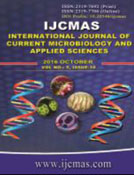


 National Academy of Agricultural Sciences (NAAS)
National Academy of Agricultural Sciences (NAAS)

|
PRINT ISSN : 2319-7692
Online ISSN : 2319-7706 Issues : 12 per year Publisher : Excellent Publishers Email : editorijcmas@gmail.com / submit@ijcmas.com Editor-in-chief: Dr.M.Prakash Index Copernicus ICV 2018: 95.39 NAAS RATING 2020: 5.38 |
Acinetobacter spp play a significant role in the colonization and infection of patients admitted to hospitals. Acinetobacter is a Gram Negative Coccobacillus. Outbreaks of infection caused by strains of A. baumannii resistant to multiple antibiotic classes, including carbapenems, are a serious concern in many specialized hospital units, including intensive care units (ICUs). Given the diversity of resistance mechanisms in A. baumannii, definitive therapy should be based on the results of antimicrobial susceptibility testing. Keeping these things mind the present study was undertaken to study the prevalence of Acinetobacter spp in clinical samples and the antimicrobial susceptibility pattern’s A total of 888 no’s clinical specimens Urine, Respiratory samples, Blood wound swab, Body fluids collected from admitted patients in wards and ICU department of GMCH for a period of one year from August 2014--July 2015. Acinetobacter isolation was done by conventional methods of culture. Species identification was done by KBO14 and by Vitek2 compact. Antimicrobial susceptibility of isolated Acinetobacter spp were tested by modified Kirby-Bauer disc diffusion method as per the recommendation of Clinical and Laboratory Standard Institute (CLSI) and VITEK 2 compact AST 281 as per guideline. Out of 888 clinical samples (31) Acinetobacter spp were isolated and prevalence was 3.49%. The maximum isolation rate was seen from respiratory specimens (45.16%) followed by urine (19.36%), wound swabs (16.13%), blood (12.90%) and body fluid (6.45%). Acinetobacter baumannii was the predominant species (90.32%) isolated, followed by Acinetobacter lwoffii(6.45%) and Acinetobacter hemolyticus (3.23%). Acinetobacter species isolated from patients in ICU was 80.65%(25). Acinetobacter baumannii were sensitive to Polymixin B (100%) followed by colistin (92.85%).The highest resistance was seen with Piperacillin tazobactum (71.43).Carbapenem resistance found in 42.85% A.baumannii. Acinetobacter spp. 38.7% (12) of isolates were MBL producers and all MBL producers were isolated from ICU.
 |
 |
 |
 |
 |